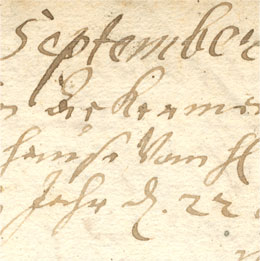How did Tallinn’s Cathedral acquire its new pulpit?
A great fire broke out on Toompea in 1684, in which Tallinn’s Cathedral was also damaged – the church’s wooden interior furnishings were completely destroyed. The new pulpit was completed by the autumn of 1686 at the latest and it was set up adjacent to the church’s eastern column on its southern side. The Christmas Day church service in 1686 was held once again in Tallinn’s Cathedral.
Who was the pulpit’s author?
Although an invoice from 1691 has been preserved, according to which the master cabinetmaker Johan Gieseken fashioned the pulpit, stylistic analysis unambiguously indicates that Christian Ackermann did the carving work for the pulpit. It could have been the joint work of these two masters. According to the above-mentioned invoice, Gieseken was paid 30 riksdalers for making the pulpit. This could not by any means have been the remuneration for the entire pulpit. Even the carvings for pulpits in rural churches cost more than 80 riksdalers at that time (the cabinetmaker’s remuneration for his part of such a job was about 20 riksdalers). Some private donor quite probably covered the cost of Ackermann’s work.
What can Ackermann’s figures on the pulpit of Tallinn’s Cathedral be compared with?
The figure of Moses carved by Ackermann supported the pulpit’s corpus, and statues of the apostles St. Peter and St. Paul adorned the door portal. Ackermann carved corbels adorned with putto faces beneath the twisted colonnettes with Corinthian capitals that articulate the pulpit’s corpus.
It is best to compare the figures of St. Peter and St. Paul standing on the pulpit’s door portal with Ackermann’s corresponding statues that were carved ten years later for the retable in the same church. It seems that just like the master, the apostles also grew older over the intervening ten years. Their faces are more individualised, the depicted emotions are amplified, and the master’s cutting line has become sharper – for instance regarding the folds of their garments.
At the same time, the figures of St. Peter and St. Paul from the pulpit of Tallinn’s Cathedral can be compared to other figures carved by Ackermann in the 1680s – the figures of St. Peter and St. Paul from the retables in the churches at Simuna and Vigala. These are statues that were similarly still carved using a relatively soft cutting line.
What happened to the pulpit fashioned by Ackermann in the 18th and 19th centuries?
The pulpit was moved from the southern side of the nave to the northern side of the chancel arch at some point in the interval 1724–1726 in order to improve its visibility from all seats.
According to the study published by Sten Karling in 1943, Johann Valentin Rabe, a wood carver from the new generation whose works are found in other Estonian churches as well, fashioned the sounding board for the relocated pulpit. New archival finds, however, indicate that the sculptor Salomon Zeltrecht, who was also associated with decorating the main hall of Kadriorg Palace at about the same time, received remuneration for work done in Tallinn’s Cathedral in the interval 17241726. Stucco sculptures of the geniuses of fame in the imperial summer palace were fashioned by Zeltrecht, as were the flower bouquets in vases above the fireplaces, and the cartouches bearing the initials of the tsar and tsarina together with the Russian imperial eagles that belong with them.
According to the account book of Tallinn’s Cathedral, the sculptor Salomon Zeltrecht was paid 54.70 roubles for his work on the pulpit and pews, and the painter Johann Heinrich Fick was paid 35.40 roubles in 1726 (TLA. 237.1.143, 1.02.1726). These men were probably connected more to the reconstruction of the pulpit as a more complex object and to supplementing the sounding board rather than to the work that was done on the pews.
The pulpit was painted, gilded, and silver-plated once again after it was moved. Previously existing panel paintings depicting the apostles were used on the pulpit’s renovated corpus and the balustrade of the new staircase. It is not known if they originated from Ackermann’s pulpit or from elsewhere. The last renewal of the pulpit’s colouring was carried out in 1866 together with the reconstruction and repainting of the church’s retable.
In what sense does the pulpit of Tallinn’s Cathedral differ from Ackermann’s other pulpits?
Instead of carved statues, paintings adorn the corpus and stair balustrade panels of the pulpit of Tallinn’s Cathedral, whereas the pulpit does not have Christ as Salvator Mundi and the foursome of evangelists.
The iconography of the new sounding board also differs from that of the sounding board from the era of Swedish rule: puttos instead of angels hold the attributes of Christ’s martyrdom on the pulpit’s new sounding board. Similarly, it is not Christ the Invincible who crowns the sounding board, but rather the globe with a cross, around which puttos flutter. The Jõhvi Church pulpit’s sounding board has the same kind of composition. Judging by its style, Sten Karling considered the Jõhvi Church pulpit to be the work of Johann Valentin Rabe, which does not, however, rule out the possibility that Salomon Zeltrecht fashioned the sounding board of the previous pulpit of Tallinn’s Cathedral and that Johann Valentin Rabe merely copied his work.
The Russian Empire’s coat-of-arms at the edge of the sounding board of the pulpit of Tallinn’s Cathedral is a sign of the upheaval that took place in both politics and church art in 1710 – Tallinn’s surrender to the Russian forces, and the fact that Estland and its church ceased to be a part of the Kingdom of Sweden while being subjected instead to the rule of the Russian tsar.
